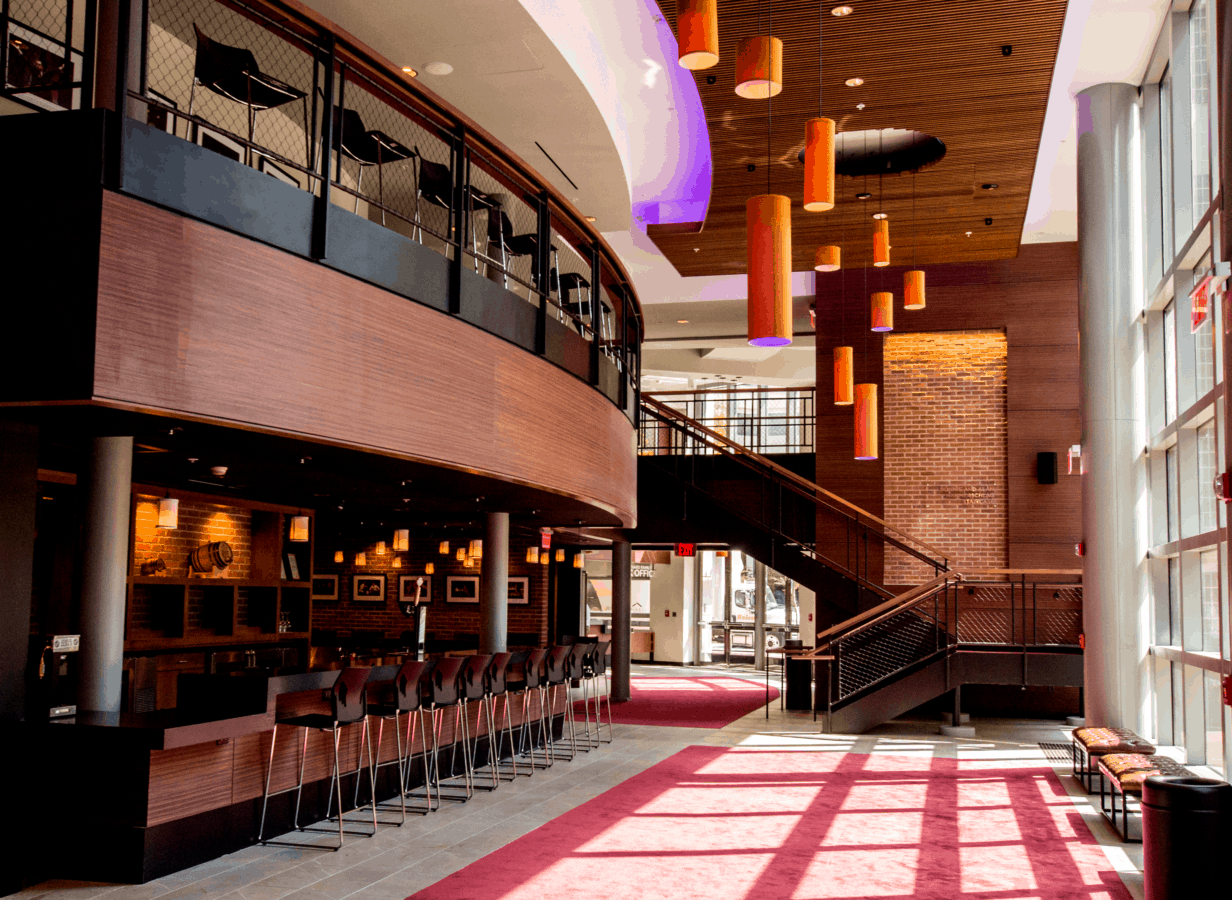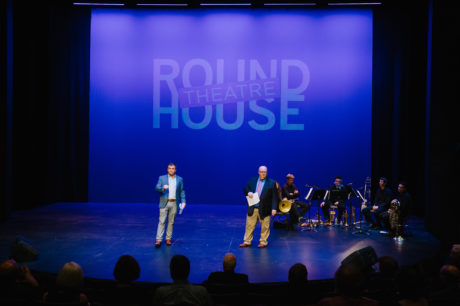Round House Theatre reopened this week after an eight-month renovation that revamped nearly every aspect of the Bethesda, MD theater space.
What began as a desire to improve the acoustics in the theater snowballed into a 9-million-dollar renovation of the entire building. “We worked to activate every aspect of the space and make it more vibrant,” Artistic Director Ryan Rillette said during a tour of the venue last week.

The new renovations promise theatergoers an enhanced experience from the moment they pick up their ticket in the restyled lobby to the cocktail or light meal they can now enjoy at the inviting and sizeable lobby bar.
Of course, the jewel in Round House’s renovations is the theater space itself. Round House was formerly hampered by a modified thrust stage, a configuration that was common in the 1990s but quickly fell out of favor with designers who realized it severely limited what directors and actors could do in the space. On top of that, the acoustics were not great. And woe to the ticket holders in the rear balcony which felt isolated and far from the stage.
The new space addresses all these problems and then some: The stage is now a true thrust design which will give directors and designers much more flexibility in staging both large-scale and intimate scenes in future shows (See below for Scenic Designer Paige Hathaway’s observations on Round House’s new thrust stage.) After determining that the size of the space was also partly responsible for the poor acoustics, the designers reduced the space by 20,000 cubic feet, moving the back wall and seating closer to the stage and integrating the balcony so that the distance between the audience and the performers feels much more intimate, no matter where you are seated.

The dark wood, exposed brick, and red seat cushions were all chosen in deference to acoustics, and the newly integrated balcony features such a porous railing that the upper level feels like a continuation of the lower space. Double doors were added to the entrance ensuring that light and sound would not penetrate the performance space if an audience member arrives late or has an ill-timed need for the bathroom.
Much consideration was given to the new lobby bar, the Fourth Wall Bar and Café, which now offers a rotating cocktail menu (formerly Round House was only licensed for beer and wine) as well as small food plates curated by Food and Beverage Manager Hudson Tang who was brought in to pair food and beverage selections to each show. That means that visitors coming to the upcoming production of School Girls; Or, The African Mean Girls Play can enjoy a menu inspired by the play’s setting in West Africa.
“People want a complete experience when they come to the theater these days,” Rilette said. Given the lack of happy hour or dining options near the theater, Rilette hopes the Round House bar will become a local destination itself. The bar will offer an artist discount and “the audience can now stick around and have a drink and mingle with actors after the show,” he said.

The design of the lobby and its shift to a holistic gathering space was influenced by theater designs in England where, Rilette and Managing Director Ed Zakreski say, the concept of making a night at the theater a complete experience, with food and drink served on site is much more common. In looking for inspiration for their new space, Rilette visited several British theaters including Liverpool’s Everyman Theatre, and London’s Young Vic and Royal Shakespeare Center where he was pleasantly surprised to see a thriving bar scene before, during, and after curtain.
Rilette and Zakreski were also influenced by theaters much closer to home. “The entire DC-area was very helpful to us during this renovation,” Zakreski said. He noted that Signature Theatre was very open in sharing what had worked and not worked when it opened its popular bar space in Arlington, Virginia.
Strathmore, Olney, Shakespeare Theatre Company, Imagination Stage, and Arena Stage were specifically mentioned as places that allowed Round House to continue performing during construction or offered advice on how to approach a major renovation. “The DC region has an incredibly supportive theater community,” Rilette noted. “There is an awareness that if one theater succeeds it’s better for all of us.”
Round House Theatre’s next production, School Girls; or, the African Mean Girls Play, plays September 18 through October 13, 2018. Round House is located at 4545 East-West Highway, in Bethesda, MD. For tickets, call (240a0 644-1100 or go online.
Scenic Designer and Round House Theatre Resident Artist Paige Hathaway on the importance of Round House’s new thrust stage:
Nicole: You mentioned that the new thrust stage will now make it easier to stage “big” numbers as well as intimate moments. Can you elaborate on that?

Paige: The new thrust is big enough that it can comfortably fit a large ensemble, but the audience seating is also closer, and the acoustics of the space are far superior to what they had been. This means that the audience will be able to connect to all scales of production in a way that they hadn’t before. For example, the design for The Curious Incident of the Dog in the Night-Time (At Round House from November 20-December 22, 2019) is going to easily accommodate huge, stylized movement sections with the entire ensemble as well as extremely small, quiet scenes between Christopher and his mother. I don’t think the old space would have been as flexible—or at least the audience wouldn’t have been able to experience this variety in staging as fully.
Give us an example of the former modified thrust stage hampering a previous production.
A perfect example of how the old configuration used to hamper us was in my design for The Book of Will. In almost every photo of the design or staging, you can see that there’s a 5-foot strip of nothing downstage center. This is because if you put any furniture or people there, you would block the views of people in the side seating banks of the house. The old configuration appeared like a thrust, but ultimately needed to be played like a proscenium, which meant that you had a lot of dead space that couldn’t be properly utilized by the designers or the director. With the new, true thrust, we can fully utilize the stage to get some really nice dynamic staging without any dead space!
What about the new thrust stage excites you the most?
More than anything, I’m excited about how close the audience feels. The balcony used to be like a no man’s land where all the action on stage felt disconnected and remote. I always hated watching shows up there, because there was nothing I could do to make the balcony feel more included in the design. Now, the balcony seats might be some of the best seats in the house! I’m excited to experience the shows as an audience member, not just a designer.




